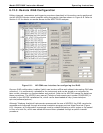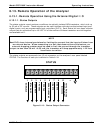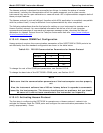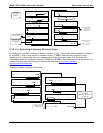
Model GFC7000E Instruction Manual Operating Instructions
04584 Rev A1 120
6.13.2.5. Status Reporting
Reporting of status messages as an audit trail is one of the three principal uses for the RS-232
interface (the other two being the command line interface for controlling the instrument and the
download of data in electronic format). You can effectively disable the reporting feature by setting
the interface to quiet mode (Section 6.10.6., Table 6-16).
Status reports include iDAS data (when reporting is enabled), warning messages, calibration and
diagnostic status messages. Refer to Appendix A-3 for a list of the possible messages, and this
section for information on controlling the instrument through the RS-232 interface.
General Message Format
All messages from the instrument (including those in response to a command line request) are in
the format:
X DDD:HH:MM [Id] MESSAGE<CRLF>
Where:
X is a command type designator, a single character indicating the message
type, as shown in the Table 6-27.
DDD:HH:MM is the time stamp, the date and time when the message was issued. It
consists of the Day-of-year (DDD) as a number from 1 to 366, the hour of
the day (HH) as a number from 00 to 23, and the minute (MM) as a number
from 00 to 59.
[ID] is the analyzer ID, a number with 1 to 4 digits.
MESSAGE is the message content that may contain warning messages, test
measurements, iDAS reports, variable values, etc.
<CRLF> is a carriage return / line feed pair, which terminates the message.
The uniform nature of the output messages makes it easy for a host computer to parse them into
an easy structure. Keep in mind that the front panel display does not give any information on the
time a message was issued, hence it is useful to log such messages for trouble-shooting and
reference purposes. Terminal emulation programs such as HyperTerminal can capture these
messages to text files for later review.
6.13.2.6. Remote Access by Modem
The MGFC7000E can be connected to a modem for remote access. This requires a cable between
the analyzer’s COM port and the modem, typically a DB-9F to DB-25M cable (available from
Teledyne Instruments with part number WR0000024).
Once the cable has been connected, check to make sure the DTE-DCE is in the correct position.
Also make sure the MGFC7000E COM port is set for a baud rate that is compatible with the
modem, which needs to operate with an 8-bit word length with one stop bit.
The first step is to turn on the MODEM ENABLE communication mode (Mode 64, Section 6.10.6).
Once this is completed, the appropriate setup command line for your modem can be entered into
the analyzer. The default setting for this feature is
AT Y0 &D0 &H0 &I0 S0=2 &B0 &N6 &M0 E0 Q1 &W0


















